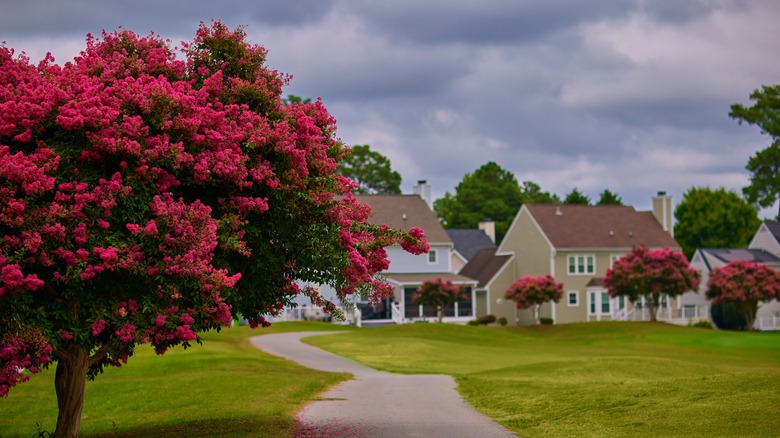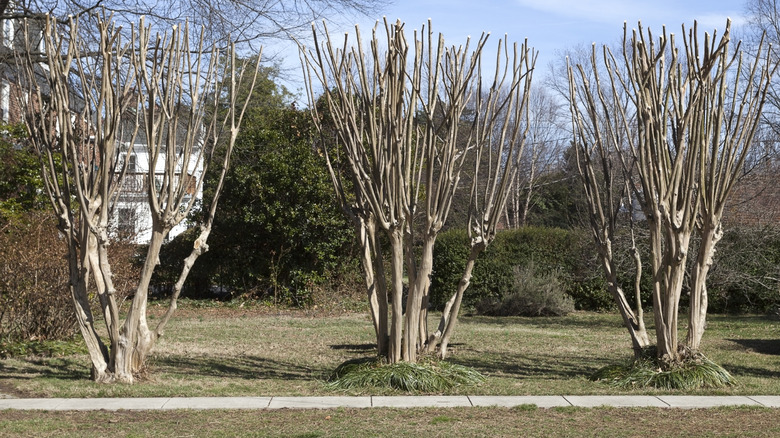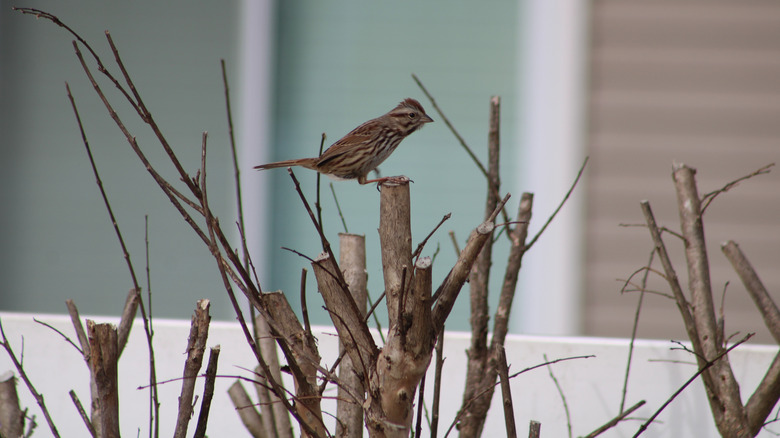Why Pro Gardeners Are Tired Of You Planting Crepe Myrtles
You may be tempted by the fluffy blooms and attractive bark on crepe myrtles, but think twice before planting one in your garden. There are many reasons why these ornamental trees from China, Korea, and Japan are not popular with professional gardeners, including their overabundance, difficulty of removal, and nonnative status. Crepe myrtle (Lagerstroemia) is so popular in both residential and public landscapes in the United States that it's become overdone. Even if you aren't concerned about making your garden stand out by avoiding a tired trend, the fact that these trees are so over-planted means that the pests and diseases that affect them are just as over-abundant. If any of your neighbors who also have crepe myrtles get hit with an invasion of pests, they can quickly spread from one tree to the next until they swarm your tree.
Pests and diseases aside, the nonnative landscape tree has plenty of other problems, too — even more if you prune it severely every year to keep it small. From regular suckers that need to be trimmed regularly to a vigorous root system that makes it nearly impossible to get rid of, there are many hidden downsides of growing a crepe myrtle tree. As a nonnative, crepe myrtles also aren't the best choice for gardeners who want to attract birds and pollinators to their yard. Fortunately, there are plenty of native alternatives that are just as ornamental, don't come with nearly as many problems as crepe myrtles, and benefit your local pollinators and wildlife just as much as they benefit your landscape.
Poor pruning practics and difficult removal should dissuade you
One issue with crepe myrtles is the widespread habit of topping the trees every winter. Dubbed "crepe murder," topping shortens the bloom period because you end up with an abundance of new shoots that produce blooms at the same time, rather than multiple flower clusters emerging in succession over a longer period. This pruning practice makes the tree vulnerable to damage during strong winds, disease, and pests, and the stress of topping can also trigger the tree to put out lots of suckers.
That suckering growth habit is a problem even if you never top the tree. You want a small, ornamental tree, but crepe myrtles want to spread into multi-stemmed shrubs or sprawling thickets. While the suckers that pop around the tree are easy enough to trim when they're still small, this is a gardening task you need to stay on top of if you want to keep it tree-shaped.
If you eventually decide you are tired of battling suckers every year, cutting a crepe myrtle down won't solve your problem. The root system can keep living and keep producing suckers for years after. Digging up the roots by hand is labor-intensive, and it will be difficult to get all of it out. But opting for herbicides instead will take repeat applications over multiple growing seasons, until the roots run out of stored energy to put out new suckers.
Nonnative plants aren't ideal for native wildlife
Crepe myrtles aren't native to the United States, even in the South. While nonnative trees can sometimes provide shelter or even food to native wildlife, they're not ideal. For one, only generalists — species that can eat a wide variety of foods — can feed on them. This leaves out a lot of birds, mammals, and insects that specialize in eating a particular family of plants or even a single species.
Next, even generalist birds can still be hurt in the long run by the decline in insects that results from the lack of plant diversity in crepe myrtle-dominated landscapes. Insects are even more likely to be specialists that can only eat the native plants they evolved with. So landscapes dominated by nonnative plants have fewer insects for birds to eat. With crepe myrtle fruits available, the birds might not starve to death, but they will either be less healthy, produce fewer offspring, or both.
If you want a small, ornamental tree but also want to support wildlife and pollinators in your garden, opt for a native alternative. For example, eastern redbud (Cercis canadensis) is a vibrant tree that will bring stunning color to your spring landscape. The U.S. native attracts hummingbirds and a variety of songbirds. It's also an important nectar source for bees and butterflies. Other great native alternatives to grow instead of crepe myrtle include American crabapple (Malus coronaria), flowering dogwood (Cornus florida), and bigfruit hawthorn (Crataegus macrosperma).


